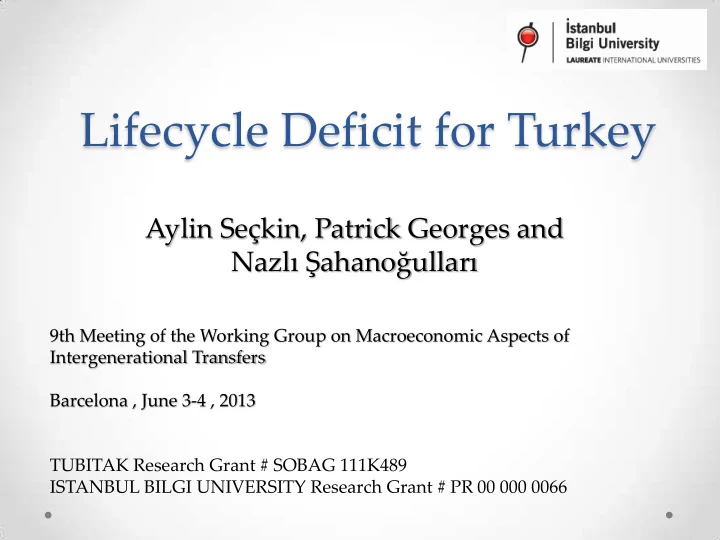

Lifecycle Deficit for Turkey Aylin Seçkin, Patrick Georges and Nazlı Şahanoğulları 9th Meeting of the Working Group on Macroeconomic Aspects of Intergenerational Transfers Barcelona , June 3-4 , 2013 TUBITAK Research Grant # SOBAG 111K489 ISTANBUL BILGI UNIVERSITY Research Grant # PR 00 000 0066
Outline • Motivation and Objectives • Data and Methodology • Structure • Results • Conclusion
Motivation • Population - Young and dynamic population with 74 627 384, end of the 2012 Fig 1: Distribution of population by age groups, 2012 Source: TURKSTAT
Motivation - Population in past, now and in the future: 1980-2000 share of young population in total population was %20 After 2000 , declining begins Young population rate 2012 16.6% 2023 15.1% 2050 11.7% 2075 10.1% Source: TURKSTAT
Motivation • Population Projections - Slower population growth and fertility rate - According to the projections for 2050, population will be 94 585 million - 2045-2050, growth rate %0.2, fertility rate %1.8 Fig 2: Population growth and fertility rates Source: TURKSTAT
Motivation • Population Aging - In 2023, share of older people is expected to be much more higher than today in Turkey. Fig 3 : Age 65+ rates by years Source: TURKSTAT
Motivation • Policies about population aging - At least three children - Turkish Prime Minister Recep Tayyip ERDOĞAN: “ One or two children mean bankruptcy. Three children mean we are not improving but not receding either. So, I repeat, at least three children are necessary in each family, because our population risks aging. We are still on the good side, as we still own a young and dynamic population. But we are slowly aging. Presently, the whole western world is trying to cope with this problem. Please do not take our susceptibility lightly, this is a very serious issue,”
Motivation • Economic impacts - Population aging causes; higher health expenditures, lower participation rate in labor market - Not sufficient amount of studies adressing the impact of population aging on Turkish economy . • National Transfer Accounts project methodology - Measuring stocks and flows in an economy - Generating an age-based database
Objective • Building Lifecycle Deficit by using National Transfer Accounts Method • By using demographic projections from UN obtaining aggregate LCDs from 1950-2050 for Turkey.
Data • Sources - Turkish Statistical Institute, Household Budget Survey, 2006 - Turkish Statistical Institute, Household Labor Force Survey, 2006 8640 HH • Data Problems - Public consumption health and education
Structures Consumption age profiles • - Private consumption: Education, health and other private consumption - Public consumption: Education, health and other public consumption Labor income age profiles • - Wages and salaries - Self employment income Aggregate control and smoothing •
Use Househol Budget Survey and Household Labor Force survey Estimations : Public and private consumptions for health, education and others Estimations: Self- employment income and earnings Smoothing and aggregate control and by using population data Lifecycle Deficit
Private Consumption Profiles • Age profile of private consumption on education • Begin at age 3 • Maximum at age 13 and 21 • Education expenditures dropping around age 22 • 0 after age 30
Private Consumption Profiles • Age profile of private consumption on health • Expenditures for babies • Age 65+
Private Consumption Profiles • Age profile of private consumption on others
Private Consumption by Sectors Private consumption by sectors, per capita, Turkey, 2006
Public Consumption • Data problems Public education ; 2002 Public health; people having private health insurance are omitted from the survey • Public education is estimated by dividing public spending by the number of students.(NTA draft)
Public Consumption Profiles • Age profile of public consumption on education Use the amount of education expenditures per student by level of education variables Methodology by NTA: Public consumption education; Where l is a school level, is unit cost per student at each level and is the number of students by age in each level.
Public Consumption Profiles • Age profile of public consumption on education
Public Consumption Profiles • Age profile of public consumption on health
Other Public Consumption Allocated equally to all population • Total public consumption; • CG(a)= CGE(a)+ CGH(a)+ CGX(a) Total consumption; • C(a)=CG(a)+CF(a)
Turkey(2006) Consumption %100 Private Consumption 92.91 • Education 1.10 • Health 3.57 • Other 88.91 Public Consumption 7.09 • Education 0.88 • Health 0.37 • Other 5.84
Labor Income Variables: wages and salaries, self employment income •
Per capita Consumption and Labor income, Turkey, 2006
Lifecycle Deficit, per capita, 2006 LCD(a)= C(a)-Yl(a) Deficit Surplus
Comparison of LCD Per Capita Source: National Transfer Accounts Database
Results of LCD, Turkey, 2006 Aggregate LCD, 2006
Assumption: Consumption and labor income profiles will be similar in future
Projections of Aggregate LCD Source: United Nations Population Projections
Conclusion • Higher private consumption • LCD>0 for ages 0-28 and 63+ • Demographic changes and LCD • Aggregate LCD of old population looks similar with LCD of young population in 2050 • Future work: Public and private reallocations
THANK YOU!!
Lifecycle Deficit for Turkey Aylin Seçkin, Patrick Georges and Nazlı Şahanoğulları 9th Meeting of the Working Group on Macroeconomic Aspects of Intergenerational Transfers Barcelona , June 3-4 , 2013 TUBITAK Research Grant # SOBAG 111K489 ISTANBUL BILGI UNIVERSITY Research Grant # PR00
Recommend
More recommend